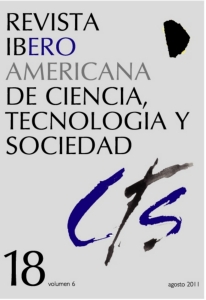The corresponding digital divide
Barriers and facilitators of the use of ICTs in middle and lower-middle class parents in Chile
DOI:
https://doi.org/10.52712/issn.1850-0013-755Keywords:
digital inclusion, digital divide, Internet, mobile phonesAbstract
This article summarizes the findings in Chile of an internationally comparative, qualitative study aimed to identify the reasons explaining why and how persons do appropriate information and communication technologies (ICTs), particularly Internet and mobile phones. This required studying a segment of population rarely analyzed, which shows considerable pressure to engage with ICTs: middle and lower-middle class mothers and fathers of children at schooling age. This was done by means of focus groups. To put these results into context, a synthesis of quantitative data from the World Internet Project (WIP) is also presented. Both authors are related to the WIP project.
Downloads
References
AVILÉS, D., GODOY, S. y SEPULVEDA, M. (2009): “Size, Structure, and Growth of the Children Information Economy”, en U. Karmarker y V. Mangal (Eds.): The UCLA Anderson Business And Information Technologies (BIT) Project. A Global Study of Business Practice, Singapur/Hackensack NJ/Londres, World Scientific Publishing Company.
CASTELLS, M. (2000): The Rise of the Network Society (2º ed.), Malden, EE.UU., Blackwell.
GODOY, S. y HERRERA, S. (2004): “Qué ocurre cuando se usa (y no se usa) Internet: resultados del World Internet Project-Chile”, Cuadernos de Información Nº 16-17, pp. 71-84.
GODOY, S. y HERRERA, S. (2008): “Precisions About the Broadband Divide in Chile”, en Y. K. Dwivedi, A. Papazafeiropoulou y J. Choudrie (Eds.): Handbook of Research in Global Diffusion of Broadband Data Transmission, Hershey, PA, IGI Global, pp. 427-445.
GODOY, S. y HELSPER, E. (2011): “The Long Tail of Digital Exclusion: a comparison between the United Kingdom and Chile”, en ICT and Performance. Towards Comprehensive Measurement and Analysis, Nueva York, The Conference Board/Fundación Telefónica (próxima edición).
HARGITTAI, E. (2002): Second Level Digital Divide: Differences in people’s online skills, First Monday, 7(4), disponible en http://firstmonday.org/htbin/cgiwrap/bin/ojs/index.php/fm/article/view/942/864.
HILBERT, M. (2010): “Digital gender divide or technologically empowered women in developing countries? A typical case of lies, damned lies, and statistics”, documento no publicado, University of Southern California (USC), Annenberg School for Communication, United Nations Economic Commission for Latin America and the Caribbean (UN-ECLAC), Information Society Programme, DDPE, disponible en:
http://www.martinhilbert.net/DigitalGenderDivide.pdf.
HELSPER, E. (2008): Digital Inclusion: An Analysis of Social Disadvantage and the Information Society, Londres, Communities and Local Government.
LIVINGSTONE, S. y HELSPER, E. (2007): “Gradations in digital inclusion: children, young people and the digital divide”, New Media & Society, 9(4), pp. 671-696.
MIDEPLAN (2010): “Encuesta Casen 2009”, Santiago de Chile, Ministerio de Planificación del Gobierno de Chile, disponible en http://www.mideplan.cl/casen2009/RESULTADOS_CASEN_2009.pdf.
MINISTERIO DE ECONOMÍA DEL GOBIERNO DE CHILE (Eds.) (2008): Estrategia Digital 2007-2012, disponible en www.estrategiadigital.gob.cl
NORRIS, P. (2001): Digital divide: Civic engagement, information poverty, and the Internet worldwide, Cambridge, MA, Cambridge University Press.
PNUD (2006): Informe Desarrollo Humano en Chile. Las nuevas tecnologías, ¿un nuevo salto al futuro?, Santiago de Chile, Programa de Naciones Unidas para el Desarrollo.
PNUD (2009): Human Development Report 2009. Overcoming barriers: Human mobility and development, disponible en http://hdr.undp.org/en/media/HDR_2009_EN_Complete.pdf.
SELWYN, N. (2004): “Reconsidering political and popular understandings of the digital divide”, New Media & Society, 6(3), pp. 341-362.
SUBTEL (2009): IV Informe de Resultados. Encuesta de Satisfacción de Usuarios de Servicios de Telecomunicaciones, Secretaria de Telecomunicaciones Ministerio de Transporte y Telecomunicaciones, disponible en ww.subtel.cl/prontus_subtel/site/artic/20100205/asocfile/20100205163927/iv_informe_subtel_n09.pdf.
VAN DIJK, J. (2005): The deepening divide: Inequality in the Information Society, Thousand Oaks, CA, EE.UU., Sage.
VAN DIJK, J. (2006). “Digital divide research, achievements and shortcomings”, Poetics, 34(4-5), pp. 221-235
WARSCHAUER, M. (2004): Technology and social inclusion: Rethinking the digital divide, Cambridge, MA, MIT Press.
WORLD ECONOMIC FORUM (2009): The Global Information Technology Report 2008-2009, disponible en www.weforum.org/pdf/gitr/2009/Rankings.pdf.
WORLD INTERNET PROJECT (2009): World Internet Project Report, Los Angeles, CA, USC Center for the Digital Future, disponible en www.digitalcenter.org/pages/site_content.asp?intGlobalId=44.
WORLD INTERNET PROJECT (2010): World Internet Project Report, Los Angeles, CA, USC Center for the Digital Future, disponible en www.digitalcenter.org/pages/site_content.asp?intGlobalId=42.
WORLD INTERNET PROJECT – CHILE (2009): Los internautas chilenos y sus símiles en el resto del mundo: resultados del estudio WIP-Chile 2008, Santiago de Chile, Facultad de Comunicaciones UC/CCS, disponible en http://comunicaciones.uc.cl/prontus_fcom/site/artic/20080418/mmedia/MULTIMEDIA_220080418230431.pdf
Downloads
Published
How to Cite
Issue
Section
License
Copyright (c) 2024 CC Attribution 4.0

This work is licensed under a Creative Commons Attribution 4.0 International License.
All CTS's issues and academic articles are under a CC-BY license.
Since 2007, CTS has provided open and free access to all its contents, including the complete archive of its quarterly edition and the different products presented in its electronic platform. This decision is based on the belief that offering free access to published materials helps to build a greater and better exchange of knowledge.
In turn, for the quarterly edition, CTS allows institutional and thematic repositories, as well as personal web pages, to self-archive articles in their post-print or editorial version, immediately after the publication of the final version of each issue and under the condition that a link to the original source will be incorporated into the self-archive.











